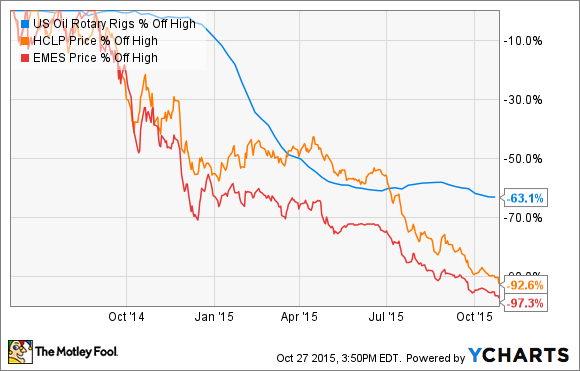It's no secret that the oil crash has laid waste to the energy industry. Oil companies are hunkering down into survival mode and slashing investment into new drilling. This is hitting frac sand producers such as Hi-Crush Partners (HCRS.Q) and Emerge Energy Services (NYSE: EMES) especially hard as the number of operating rigs continues to decline and take demand for frac sand with it.

US Oil Rotary Rigs data by YCharts
Hi-Crush's third quarter earnings brought some especially bad news. Management suspended its distribution which sent the MLP's price crashing 23% the next day.
Let's take a look at just how bad the situation has become for one of America's largest frac sand miners, and more importantly just how grim management expects the future to be.
Plunging sales and crashing margins lead to payout suspension
| Metric | Q3 2015 | Q3 2014 | Year Over Year Change |
| Revenue | $81 million | $102 million | -21% |
| Adjusted EBITDA | $13 million | $44 million | -70% |
| Distributable Cash Flow (DCF) | $10.3 million | $32.3 million | -68% |
Source: Hi-Crush Partners Q3 earnings release
As you can from this table Hi-Crush's DCF fell off a cliff and could no longer sustain the $17.6 million cost of last quarter's payout. Rather than tap into its cash reserves to pay investors, management made the painful but correct decision to suspend the distribution.
This wasn't completely unexpected since Emerge Energy recently announced that it failed to generate any DCF in the past three months and would thus also be making no distribution this quarter.
H-Crush Co-CEO Robert Rasmus explained that the decision was based on what management believed to be in the best interest of the partnership and thus long-term investors.
This is about prudent preservation of capital, building market share and positioning Hi-Crush for the eventual market turnaround. We continue to believe the fundamentals for increased frac sand demand over the long-term are favorable, but the recovery will take longer than previously thought.
Some good news
As the above quote makes clear Hi-Crush is hunkering down and thinking about how best to strengthen its position among its competitors. For example, it's slashed its workforce 16% as part of an effort to minimize costs so that it can better compete on price and win market share.
In fact Hi-Crush was able to increase its volume of sand sold 18% compared to both last quarter and last year. Unfortunately the price it received per ton declined 15% from $67 to $57. To compensate for the decreased margins Hi-Crush idled its higher cost Augusta, Wisconsin facility. This helped lower its production costs to $11.32 per ton, 16% and 19% less than Q2 2015 and Q3 2014, respectively.
Digging in for a harsh winter
In the short-term Hi-Crush doesn't see things improving much. In fact management warned that next quarter is likely to be even worse.
"Given...our customers' anticipation of much greater than the usual seasonal declines across the industry, we expect the downward trend in well completion activity to continue in the fourth quarter with more pressure on pricing and reduced sequential sales volumes."-Laura Fulton, CFO
In order to maximize its chances of surviving the oil crash Hi-Crush is focusing on preserving as much liquidity as possible and strengthening its balance sheet. Thus the suspension of the distribution which had an annual cost of $70.4 million.
Management is also planning to slash its capital expenditure budget from 2015's $50 million to $55 million to just $15 million to $25 million next year. The goal is to minimize the need to tap the MLP's remaining $90 million credit revolver in order to keep its Net Debt/Adjusted EBITDA ratio as low as possible. That's because that ratio is currently 2.4 due to Hi-Crush's $252 million in long-term outstanding debt. Its debt covenants require the ratio remain below 3.5.
With the short-term outlook for frac sand volumes and prices so negative it's likely that Hi-Crush's Adjusted EBITDA will continue to decline in the quarters ahead. Should it breech its debt covenants then its creditors could call in its loans and potentially force the MLP to recapitalize by selling assets and additional equity. Of course thanks to the oil crash the value of both frac sand mines and Hi-Crush's units are in the toilet. Thus such a recapitalization could very well wipe out existing unit holders.
What should long-term investors do now?
As painful as the elimination of Hi-Crush's distribution is the most important thing for long-term investors is to not panic. Instead focus on the fact that one day oil prices will inevitably rebound. When that happens over 3,000 uncompleted oil and gas wells as well as nearly 50,000 refracking eligible wells will likely greatly increase both demand for and the price of frac sand.
At that time Hi-Crush should be able to reinstate its payout and those who were brave and patient enough to add and hold during the darkest days of the downturn will likely be richly rewarded.





